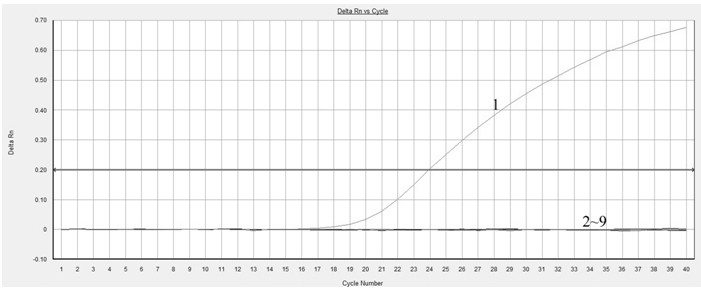A method for detection and identification of Helicodon snails by fluorescent quantitative PCR
A fluorescent quantitative and snail technology, which is applied in the field of molecular biology detection and identification, can solve problems such as fluorescence quantitative PCR of snails that have not yet been seen, and achieve the effect of accurate and convenient result determination and strong specificity
- Summary
- Abstract
- Description
- Claims
- Application Information
AI Technical Summary
Problems solved by technology
Method used
Image
Examples
Embodiment 1
[0018] Example 1: Primer Specificity Test of Fluorescence Quantitative PCR of Helical Snail
[0019] 1. Preparation of materials
[0020] The snails for testing are as follows: snail with upper spiral teeth, large snail, bright snail, worm Yin's snail, pizza tea snail, Jiangxiba snail, garden onion snail, forest onion snail.
[0021] The above-mentioned snails were intercepted in the national port quarantine or obtained through domestic investigation and collection. After being confirmed by the National Mollusc Quarantine and Identification Key Laboratory of the former General Administration of Quality Supervision, Inspection and Quarantine, they were stored at -20°C for later use.
[0022] 2. Establishment of fluorescent quantitative PCR method
[0023] 2.1. Design and synthesis of primers: Based on the COI gene sequence of Helicodon snail, the primer design software PrimerExpress3 was used to assist in the design and analysis of primers. After the specificity was tested by ...
Embodiment 2
[0031] Example 2: Detection Sensitivity Test of Fluorescent Quantitative PCR for Helicopterus snail
[0032]The DNA stock solution (100 ng / μL) extracted in Example 1 was diluted into 10 ng / μL, 1 ng / μL, 100 pg / μL, 10 pg / μL, 1 pg / μL, 8 different concentration gradients of 100 fg / μL, 10 fg / μL and 1fg / μL are marked as 1-9 respectively, and curve 10 is the blank control.
[0033] Fluorescence quantitative PCR amplification reaction system: the total volume is 25 μL, including 12.5 μL of 2×Premix Ex TaqTM PCR (ProbeqPCR), 1 μL of upstream and downstream primers and probes, 2 μL of 100 ng / μL DNA template, 0.5 μL of ROXII, and the rest with inert ddH 2 O make up. After mixing, put it into a fluorescent quantitative PCR amplification instrument for amplification.
[0034] The two-step amplification reaction program of fluorescent quantitative PCR is: pre-denaturation at 95°C for 3 minutes; 40 cycles of 10s at 95°C and 40s at 60°C; and the end of the reaction.
[0035] Judgment of f...
PUM
 Login to View More
Login to View More Abstract
Description
Claims
Application Information
 Login to View More
Login to View More - R&D
- Intellectual Property
- Life Sciences
- Materials
- Tech Scout
- Unparalleled Data Quality
- Higher Quality Content
- 60% Fewer Hallucinations
Browse by: Latest US Patents, China's latest patents, Technical Efficacy Thesaurus, Application Domain, Technology Topic, Popular Technical Reports.
© 2025 PatSnap. All rights reserved.Legal|Privacy policy|Modern Slavery Act Transparency Statement|Sitemap|About US| Contact US: help@patsnap.com


